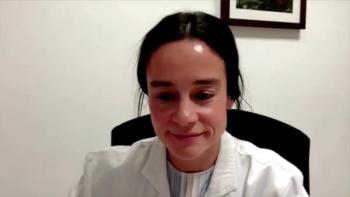
The Impact of FVC Decline and Lung Function in IPF
Toby Maher, MD, PhD, professor of clinical medicine, Keck Medicine of USC, discusses the impact of changes in lung function in patients with idiopathic pulmonary fibrosis (IPF).
The rate of forced vital capacity (FVC) decline in patients with idiopathic pulmonary fibrosis (IPF) is 10 times faster than in healthy individuals, predicting disease severity and survival, says Toby Maher, MD, PhD, professor of clinical medicine, Keck Medicine of USC.
Transcript
How does the rate of decline in FVC in patients with IPF and progressive pulmonary fibrosis (PPF) compare with healthy individuals, and what implications does this have for assessing disease progression and tailoring treatment strategies?
Forced vital capacity, which is essentially a measure of lung volume, allows us to identify patients with disease, and it allows us to monitor disease. Now, sadly, once all of us get over the age of 35, we'll begin to lose lung function slowly, year on year. So, on average, an adult will lose about 27 mL of FVC every 12 months of their life after [age] 35. Patients with idiopathic pulmonary fibrosis typically lose about 240 mL of FVC in 12 months, so they're losing lung function 10 times faster.
We’ve done several studies now in the past that show the speed with which IPF patients lose lung function predicts their outcome. So, the faster they're losing it, the more rapidly progressive their disease is, [and] the sooner they are going to die from their condition. And it's that rationale that underpins using the forced vital capacity as the end point in IPF and PPF clinical trials. If we can slow down progression, then we will improve survival. The work has been done following the pirfenidone and nintedanib clinical trials to show that genuinely, if you slow FVC progression, that has important survival implications down the line. So that's really the reason that we focus so much on the FVC in this disease area, and why we see it as important to treat early and aggressively to try and prevent loss of FVC over time.
How do changes in lung function over time correlate with mortality risk in patients with IPF, and what are the most effective strategies for monitoring and managing these changes to improve patient outcomes?
As we've already alluded to, once patients have pulmonary fibrosis, they will lose forced vital capacity over time. That happens in 1 of 2 ways. In most patients, as the disease progresses, they sort of gradually lose lung function at a fairly constant rate. But the other scenario we see is patients having acute exacerbations where they suddenly develop sort of widespread injury and damage to the lungs, and in that case, they can sort of have stepwise deterioration in their lung function. That has led us not only to use forced vital capacity in clinical trials, but also in our clinical practice. We use it as a tool for monitoring disease progression. Traditionally, we've measured it every time patients come to clinic. So, every 3 or 4 months we will measure their forced vital capacity. More recently, we've started using handheld devices so that patients can monitor their FVC at home. And we think that may be a good way of picking up these sudden declines, so that we can try and sort of intervene with treatments at an early stage. So, if we can identify what's causing the decline, whether it's an infection or inflammation, we can think about treating that in addition to using the antifibrotic drugs in the first place to try and prevent that sort of gradual decline that's associated with disease.
Newsletter
Stay ahead of policy, cost, and value—subscribe to AJMC for expert insights at the intersection of clinical care and health economics.







































